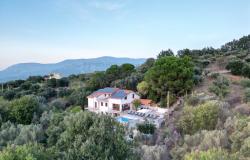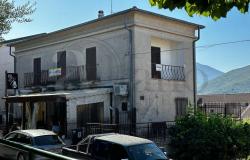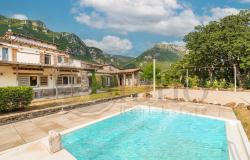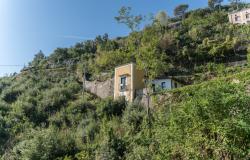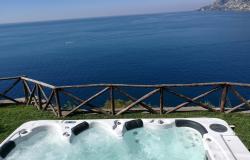some links
Submitted by adriatica on Mon, 08/03/2009 - 18:16In reply to A newbie all over again! by Annec
the first two are italian sites which make these fotovoltaico panels.. you can use google to see if you can find more locally www.heliostechnology.info/EN/ http://www.brandonisolare.com/index_uk/index_uk.html however... you do get grants here but they are set against tax paid...ie you need to be working here to get any reductions in the price...and even with that they still will take you until your dead to get any return... economically i mean... yes they will svae the planet but not your money... its still much cheaper to pay a polluting company like enel to produce the energy for you... if you choose a system which only produces 3kw of energy then you are pretty unlikely to even break even let alone save the planet at any time... the only way to do this logically providing money is no problem for you is to produce more than you need... at least double what you are talking about and sell the extra into the grid...and when the sun goes down you are suppplied back from the grid... or on a cloudy day... but at 3 kw you are not going to be supplying much in...anyway the websites will tell all... its not a choice i would make... if cost is a parameter... especialley if you do not work and pay tax here...just doesnt make finacial sense..they cost a fortune these systems.....if your looking for cost effective measuers as against save the planet then the only form of solar technology at the moment which is effective in the sense of cost is solar panels which produce heated water... heres the last site...Italian only i think ...but based in Caserta... designs and installs the systems...http://www.rbingegneria.it/index.php?p=servizi&c=19
Very good advice from
Submitted by Capo Boi on Tue, 08/04/2009 - 08:20In reply to A newbie all over again! by Annec
Very good advice from Adriatica. I would agree with everything said. To generate 3kw plus takes a lot of panels. Also, one thing that is often overlooked is that to generate at maximum efficiency the panels have to be scrupulously clean. The sand carrying sirocco wind can have a big affect on performance.
Cost Examples Photovoltaic
Submitted by Badger on Tue, 08/04/2009 - 09:05In reply to A newbie all over again! by Annec
This is a good site, that will give an estimated cost per Watt of Panels. Multiply by 1000 to get the per Kw supply average. You may be able to get better deals, but this is a good guide.Estherina, if this is to overcome the electricity supply problem from an earlier post, then it would probably be as cheap to have a cable put underground ( depending on the distance ), to solve your neighbours objections.http://www.solarbuzz.com/Moduleprices.htm
Photovoltaics or Solar?
Submitted by Sablanico on Wed, 08/05/2009 - 05:05In reply to A newbie all over again! by Annec
Hi,I think you guys are mixing photovoltaics (generating electricity) and solar (heating water) up a bit....Solar panels for heating water comes in under the scheme of 55% tax reduction, if you can demonstrate "efficient energy improvement of your house" meaning that you have to obtain a certificate of energy efficiency for your property.It is also true that you will only be able to benefit from this if you do a tax declaration in Italy.But that doesn't mean that it is not a good idea..A PV-array for generating electricity falls under the Italian government incentivation scheme called "conto energia", which basically means that you pay and install your PV-array, apply for the incentives and get paid something like 0,39-0,49 euro/kWh this installation produces during a period of 20 years. At the same time you will have net-metering (scambio sul posto) meaning that exess production not consumed during the day will be sent into the eletrical grid, while you will consume from the grid at night when the PV-array does not produce. This will be equalled out on your ENEL bill, so that it will be practically zero. A good thing in these times with rising electricity prices.Approval of incentives is automatic if the installation is done correctly, and your array will pay itself back in 8-10 years, depending on your type of financing. Many people make a mortgage, but there are banks specialising in photovoltaics, where the will anticipate the sum for installation against you creating an account for the incentives, being used to pay back the loan. They call it leasing, in this case the plant will become "yours" after typically 10 years. But you'll still have the benefit of a zero-electricity bill.It is not energy-efficient to use a PV-array to generate electricity to then heat water, but everybody does as he think's best.You should count on an installation price of around 5500 euros/kWh, but it depends on how complicated the installation is (roof, on ground etc.). It is important that you choose an installer that provides quality panels and inverter, so do look at the guarantees before buying, you want your installation to last for 20+ years without problems.It is not true that sand deposits are such a big problem, we made a test on our 45 kWp array installed in the back of our olive grove, measuring output before and after washing with water - and saw no difference in output.Now we just let the rain take care of the cleaning. However it does also depend on the angle of the panels, optimal angle is 30 degrees, like ours, that doesn't give any problems with snow either, as it just slides off. At a smaller angle, i.e. installed on roof, the problem with deposits may be greater.However the installation contract should include a checkup after the first year and some kind of maintenance clause.The ONLY AUTHORITATIVE WEBSITE (and thereby most reliable) regarding the PV-incentivation is:http://www.gse.it/Pagine/default.aspxEverything is explained there, it is GSE that erogates the incentives.You don't need to have residency, it is enough that the installation is done on italian territory. But you need both CF and a bank account, I think.It is definitely a good idea, if you have a bit of money to spare, it will also increase the value of your house.The incentivation scheme will eventually run out of money, and I think Italians are extremely silly not to invest more while they can...Only thing I'm not completely sure of, is how ENEL handles the net surplus of energy provided from your installation if you don't live in your house all year round, ie. if you get the money back at the end of the year or it is calculated as a credit in kind..Anyway, good luck  Lizhttp://www.studio-eos.eu
Lizhttp://www.studio-eos.eu
surface area
Submitted by Sablanico on Wed, 08/05/2009 - 05:07In reply to A newbie all over again! by Annec
companies in campania
Submitted by Sablanico on Wed, 08/05/2009 - 05:12In reply to A newbie all over again! by Annec
This site links the top websites in photovoltaics, click on your region and the registered company websites will appear.http://www.top100-solar.it/index.php?region=CM..now I really need to get some work done..
thank you for all your
Submitted by estherina34 on Wed, 08/05/2009 - 14:04In reply to A newbie all over again! by Annec
thank you for all your comments...lots of website to mull over...im only looking for an electricity supply ,not to heat water up,so that may change few things...but have seen this site on ebay....http://cgi.ebay.co.uk/3KW-Stand-Alone-Solar-System-Complete-Package-12v-New_W0QQitemZ400063623850QQcmdZViewItemQQptZUK_Home_Garden_PowerTools_SM?hash=item5d25a672aa&_trksid=p3286.c0.m14
the ebay ad you were looking
Submitted by nickbass on Wed, 08/05/2009 - 19:28In reply to thank you for all your by estherina34
the ebay ad you were looking at is for 240w output panels only.,(2 x120w) the inverter can handle 3kw. i would suggest saving as much power as possible . insulate well . fit energy saving light bulbs. use solar exterior lighting. use solar hot water and if you have a pool , use solar hot water for that. remember that pv systems dont include batteries, another high cost. old milk floats/ submarinebatteries are a great solution but like rocking horse s*** to find. and i have looked myself. maplins in the uk have a sale on for 60 watt panels at £199 .nickbass
eight square metres!
Submitted by elliven on Wed, 08/05/2009 - 17:05In reply to A newbie all over again! by Annec
That's an awful lot of sq metres per kilowatt. Personally I think solar electricity for domestic use is a non-starter except for very specialised circumstances and then only if you can be very careful about usage levels. As for solar hot water systems, yes they can work, particularly well in high summer but who needs lashings of hot water at that time of year? Now if you could use that hot water to produce air conditioning - now you're talking!
solar air con
Submitted by nickbass on Wed, 08/05/2009 - 19:32In reply to A newbie all over again! by Annec
I was told that it is
Submitted by Annec on Wed, 08/05/2009 - 19:39In reply to A newbie all over again! by Annec
I was told that it is possible to get a zero-interest loan from Italian banks for PV installation. And I don't see why you'd need batteries - I understood that you feed into the grid and are credited accordingly. Hence the old story of your electricity meter running backwards!Or have I got it wrong
No, you've got it right
Submitted by Sablanico on Thu, 08/06/2009 - 04:20In reply to I was told that it is by Annec
No, you've got it right :-) You DON'T need batteries, if you are feeding into the grid.That also means that it is absolutely irrelevant whether you match your energy consumption or not. A PV-installation will normally produce excess electricity in summer, where your electricity accounting will be "positive" and perhaps too little in winter, but on an annual basis this will be EVENED OUT on the net metering. If you're positive, ENEL will give you an "energy credit" to be consumed in the future.The PV-installation will normally be designed to MATCH your electricity consumption, if space for panels allow for it. Then panel prices go down and efficiency goes up continously, so installation area and investment changes rapidly, but the incentives eventually run out, and now it is a secure investment in an economically fragile climate, and the last 10-20 years of installation life, incentives and electricity will all go in your pocket.You normally use gas for heating here in Italy, so I can't see the big relevance with regard to insulation, but I agree that it is the easiest place to start energy saving, something that we should all consider.The ONLY drawback may be the relatively high initial investment 20.000 euros for a 3 kWp system, but the banks are generally positive about this.I've not heard about zero-interest loans from any bank ever...normally they offer interest rates like EURIBOR + 0,75 or 1 %.There are no government incentives for stand-alone PV-systems with batteries, which may be a very viable solution in isolated mountain areas with no electricity. Generally batteries lower efficiency a lot, but when you are talking electricity vs. no electricity, it's worth considering.
In reply to I was told that it is by Annec
annne hers the enels site expalnation of using a 1.5 kw supply attached to the grid...very clear... it also lists other variations of power input to the grid and costs... shows the loan rate plus electricity benefits... not sying you use enel... although they might be as good as anyone...banks here are queueing up to loan on this type of thing... its about all they will loan on now ...maybe there is some sort of government guarantee within it... http://www.enel.it/enelsi/offerta/casa_risp_energetico/imp_fotovoltaici/ftv_imp_1_5/ thats the site and presume you can get a free estimate off of them for actual on site installation as all sites seem to have get out clauses on these regarding any difficulty in siting and installing panels and the rest of the equipment...
I would "out of priciple" not choose Enel, because as a former state owned company with loads of conflict of interest, they have been a major obstacle to the diffusion of alternative energy here in Italy.That said, their offers are probably as valid as anybody elses.Get 3 estimates for an installation "chiavi in mano" from 3 installation companies near you, evaulate guarantees on panels and inverter, future maintenance etc. and choose the one that seems to "know what they're doing".My husband is a PV project engineer, and when he makes estimates they also include the economic simulation of your payback time, drawings, and they will help the client with contacts to banks etc.His company only moves outside Abruzzo in case of big installations, but, if you're in doubt about what estimate to choose, you may PM me and I'll get him to have a quick look at it.Good luck :-)
Return on investment
Submitted by sprostoni on Thu, 08/06/2009 - 04:40In reply to I was told that it is by Annec
The big issue for me on PV/Solar is the long term lack of return on the initial investment of (say) 20,000 euros for a 3Kw feed. I have a 6.6Kw Enel feed to my house(4 bed with pool), my actual Enel costs are running at about 1200 euros per year. Even without interest on any loan (if you needed one), it would take me some 17 years to spend 20,000 with Enel!Alongside all this is the fact that I get double the feed, there SURELY will be some issues with the PV/Solar installation in the 17 year period I assume, but then, on the other hand Enel prices could(will) go up.If governments are so keen on us saving energy or harnessing new energies, why don't they make it MUCH more financially viable for us all? S
calculating GSE incentives
Submitted by Sablanico on Thu, 08/06/2009 - 05:28In reply to Return on investment by sprostoni
Your calculation is right, if you only consider your consumption.You have not taken into account that GSE is incentivating you in "conto energia" for a 20-year period.Practically, that means thay you are paid a "premium" that varies from0,353 euro/kWh (for a PV-installation greater than 20 kWp with no architectonic integration into the building) to 0,48 euro/kWh for a small PV-installation (1-3 kWp fully integrated architectonically).This premium will be paid to you for every kWp produced over a 20 year period. So it can be considered an income. It doesn't matter if you consume the energy yourself or you feed it into the grid. Instead of net-metering you can also sell it to ENEL, we sell our production at 0,09 euro/kWh. Our 45 kWp array required an intial investment of 180.000 euros, because my husband did all the work himself (together I think we pulled something like 1300 meters of wiring...) and in the first year of production, it generated 28.000 euros in incentives and sale. It will pay itself back in 8 years. Allthough production may go down a bit, it won't lower more than 20 %, so year 9 it will give us an income of 20.000+ euros/year - and that is without working..!If you install a PV-array of 6,6 kWp (well, it doesn't actually compare as you should dimension the peak power so that the production is roughly covering your annual consumption in kWh), you would fall in the intermediate incentivation group (3-20 kWp installations), which pays 0,372 euro/kWh for an installation that is not integrated architectonically (i.e. ground installation), 0,412 euro/kWh for a partly integrated installation and 0,451 euro/kWh for a fully integrated installation (substitution of house roof, roof on car park etc.)Most privates will argue that an 8-10 year return on investment is still long, but you do have free electricity in that period (if you don't choose to sell it), and you still have the last 10 years of incentives down your pocket. You should not see it as a way to make quick money, because it's not, more like a way to become independent of the (rising) energy prices, protecting the environment, transmitting good vibes to your stakeholders etc.On the other hand, the PV-industry says that the italian incentives are far too high, so...it really depends on the eyes that see.Hm, did I manage to convince anyone yet? 
From some of the research
Submitted by Badger on Thu, 08/06/2009 - 05:40In reply to A newbie all over again! by Annec
From some of the research that I carried out when looking into PV systems, it seems like the inverter is the part most likely to fail. They seem to only have a life span of anything between 5-12 years and can be quite expensive to replace.E 10000.00 is a lot of money to pay out for 1.5kw. We have a 15Kw 3Phase supply here, that runs a geothermal heat pump and all the house is electric. Enels bills for last year totalled E2500, cost breakdown approx 50/50 between domestic use and heat pump.To get the same supply with PV would cost a fortune and by the time of break-even I would probably be pushing up the daisies!!!!
seems to be some confusion
Submitted by Sablanico on Thu, 08/06/2009 - 07:48In reply to From some of the research by Badger
Attention, PV basics:A 3 kWp installation means a PV-array with a nominal power of 3 kW.This is calculated multiplying the number of panels with their target power (written on them).So if each module is 220 Watt (Wp), you'd need what: 3000:220= 14 panels(modules) to build a 3 kWp installation.As there are losses in inverters, wiring etc. you'll never actually optain that output, it is the nominal power, ie. the max. theoretical output of your installation.Now, depending on your Italian region, inclination of your panels, shadowing, this panel with produce electricity depending on sunshine during the various seasons, which, over a one-year period will sum up to X kWh (kilowatthours).General guidelines for Italy (with optimal angolation 30 degrees and panels directed vs. South, no shadowing), the electricity production from a PV-installation of 1 kWp nominal power amounts to:
- Northern Italy 1.000 – 1.100 kWh/year
- Central Italy 1.200 – 1.300 kWh/year
- Southern Italy 1.400 – 1.500 kWh/year
So, being cautious, a 3 kWp installation here in Abruzzo would generate approximately 3 x 1200 kWh = 3600 kWh/year of electricity.How much electricity do you consume in a year in kWh? That is the number you should look at, together with the cost of this electricity, to determine the viability of a PV-installation.You have a 15 kW 3 phase supply because you probably have high peak consumptions, but that does not mean that you necessarily need a 15 kWp array to cover your annual consumption. In high consumption periods you can take the extra electricity from the grid. That is what the net-metering system is there for.A PV-installation is not necessarily a viable solution in all cases, and you already have a geothermal system. But most installation companies do their proposals and energy calculations adapted to your specific conditions. Proposals are normally free, so it is silly not at least to ASK for 2 or 3 - evaluate the economics and THEN decide whether to go ahead or not.The new inverter costs as the first inverter, with time probably less, but it is prudent to calculate one replacement of the inverter during the 20-year period. This cost is almost always included in the economic analysis under "maintenance". That is also why it is important to use quality material (how many years of guarantees are offered on the materials) and not the first DIY-set found on ebay - unless you're just looking into playing around with garden lighting 
Last year, I used 9990 Kw, I
Submitted by Badger on Thu, 08/06/2009 - 08:14In reply to A newbie all over again! by Annec
Last year, I used 9990 Kw, I know that I could drop down to a 9 Kw supply if I wanted to, but the cost is in no way warranted with the PV installation costs. It is only just over E1.00 per month for every KW supplied by Enel. By your calculations to reach the same generated amount from PV, then I would need probably the same minimum in PV panels and that gives room for very little variance in increased use. Pump uses 2.1Kw when operating, plus either 3/6/9 Kw electric backup if needed. I only have 3Kw set, to allow for peak water heating to prevent legionnaires bacteria breeding.Costwise therefore, I would not gain anything, as I would use virtually the total generated power each year, but with an expenditure of in excess of E40000.00.
hm, didn't get it..
Submitted by Sablanico on Thu, 08/06/2009 - 10:55In reply to A newbie all over again! by Annec
Now it's me that don't get it... You consumed 9990 kWh last year.If you would want to cover all that electricity with PV, you should probably install a 8-9 kWp plant, depending on your location etc.As a rough estimate that would cost you 9 kWp x 5500 euro/kWp = 50.000 euro. A neat sum, ok.Which you do or don't want to spend for various reasons.But who said you can't keep your 15 kW supply from Enel, if that's what you need?You're connected to the ENEL grid as always, just have an extra meter running backwards when you produce excess and forward when you need to take from the grid..Also, nobody says that a PV-installation HAS to cover all your consumption - the extra consumtion you just pay as you've always done...it will just reduce your electricity bill proportionally.9 kWp requires some area (roughly 72 m2), but you could i.e. make an outdoor wood-structure as shade roof for cars, or shade next to the pool, as a total integrated solution.GSE would then pay you 9000 kWh x 0,45 euro/kWh = 4050 euro/year in premium for 20 years, payback would then be 12 years. The last 8 years fo the contract will be money earned.At the same time you have a reduced electricity bill (well, if we supposed 9000 kWh) it should be next to zero.VERY simplified, that is.Maybe all your electricity doesn't cost the same, so maybe it is not viable for you to cover your full consumption if the last consumed kWh cost less, so you should ask for a detailed economic analysis.Anyway, every situation is different...useless to try to generalise, just trying to make the mechanism clear.Obviously GSE is not a gift shop, but you benefit in terms of independence of energy price, "green" business image etc.Everybody does as he think's best.In the meantime Italy is going back to nuclear energy...http://www.affaritaliani.it/ultimissime/flash.asp?ticker=030809085327
You consumed 9990 kWh last year.If you would want to cover all that electricity with PV, you should probably install a 8-9 kWp plant, depending on your location etc.As a rough estimate that would cost you 9 kWp x 5500 euro/kWp = 50.000 euro. A neat sum, ok.Which you do or don't want to spend for various reasons.But who said you can't keep your 15 kW supply from Enel, if that's what you need?You're connected to the ENEL grid as always, just have an extra meter running backwards when you produce excess and forward when you need to take from the grid..Also, nobody says that a PV-installation HAS to cover all your consumption - the extra consumtion you just pay as you've always done...it will just reduce your electricity bill proportionally.9 kWp requires some area (roughly 72 m2), but you could i.e. make an outdoor wood-structure as shade roof for cars, or shade next to the pool, as a total integrated solution.GSE would then pay you 9000 kWh x 0,45 euro/kWh = 4050 euro/year in premium for 20 years, payback would then be 12 years. The last 8 years fo the contract will be money earned.At the same time you have a reduced electricity bill (well, if we supposed 9000 kWh) it should be next to zero.VERY simplified, that is.Maybe all your electricity doesn't cost the same, so maybe it is not viable for you to cover your full consumption if the last consumed kWh cost less, so you should ask for a detailed economic analysis.Anyway, every situation is different...useless to try to generalise, just trying to make the mechanism clear.Obviously GSE is not a gift shop, but you benefit in terms of independence of energy price, "green" business image etc.Everybody does as he think's best.In the meantime Italy is going back to nuclear energy...http://www.affaritaliani.it/ultimissime/flash.asp?ticker=030809085327
Now even I am confused.
Submitted by Badger on Thu, 08/06/2009 - 12:40In reply to A newbie all over again! by Annec
Sorry, should have put the standing Enel supply charge is just over E1.00 per Kw per month.On your figures,9 kw of panels. cost 50k. Enel pay me 4k approx for the 9 kw that I supply them with per year. My normal electricity cost is 2.5k per year, so I make in theory after my use, 1.5k.p.a.I still have a electricity bill to pay, albeit at lower cost than what I am getting back for the supply.Therefore over the 12 years to the break even point, I have made 18k in theory . Then the next 8 years are still going to be approximately the same as consumption will not change substantially, so another 12K. On that basis the 50k initial investment is then still not fully returned. As the life of the panels are say 20 years, then it would be obvious that replacement costs are again going to be high, so then we start all over again with possibly not such good supply incentives.Please correct me if I am wrong on this.
In reply to A newbie all over again! by Annec
If you just built a 9 kWp PV-array producing approx. 9000 kWh/year, and say, you decided to SELL the produced energy instead of using the net-metering, it would look something like:Premium in conto energia: 9000 kWh/year x 0,45 euro/kWh = 4050 euro/yearSale of produced energy to ENEL: 9000 kWh/year x 0,09 euro/kWh = 810 euro/yearTotal annual "income": 4860 euro.Simple return on investment: 50 000 : 4860 euro = 10,30 years. Then you'll have to pay for your electricity as always, but if your electricity bill is above 810 euro/year, it may be more convenient to use the net-metering, since it means that you buy at a higher price than you sell...but I'm not into the twists of calculating this.Here it would also be necessary to account for reduced efficiency of panels over the years, most guarantee max. decrease of 10-20%. But they'll probably be producing longer than the incentivation period anyway..and even though you won't have the premium, you'll still have the energy to sell/use.And you're right that with time, due to reduced prices, the incentivation scheme will decrease accordingly.
Thanks, Sablanico for your
Submitted by Badger on Sun, 08/09/2009 - 09:30In reply to A newbie all over again! by Annec
Thanks, Sablanico for your answer. I have a client who was interested in having a PV installation to operate their already installed geothermal unit. 17Kw output, with 3.7kw input for underfloor heating @35c, and hot water. Total set energy consumption approx 7kw, so therefore min 6kw required with electricity backup.From what you have said earlier, in quotations below, then it would be helpful to know the " twists " involved. "Then you'll have to pay for your electricity as always, but if your electricity bill is above 810 euro/year, it may be more convenient to use the net-metering, since it means that you buy at a higher price than you sell...but I'm not into the twists of calculating this."I apologise if I sound a little negative, but I am also sure that many more people in the community would appreciate more clarification, as obviously a PV installation involves a very high expenditure.






